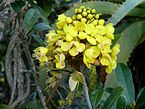Acridocarpus natalitius
| Acridocarpus natalitius | |
|---|---|

| |
| Acridocapus natalitius at Kew Gardens | |
| Scientific classification | |
| Kingdom: | Plantae |
| Clade: | Tracheophytes |
| Clade: | Angiosperms |
| Clade: | Eudicots |
| Clade: | Rosids |
| Order: | Malpighiales |
| Family: | Malpighiaceae |
| Genus: | Acridocarpus |
| Species: | A. natalitius
|
| Binomial name | |
| Acridocarpus natalitius | |
| Synonyms[1] | |
| |
Acridocarpus natalitius, the moth fruit, is a species of plant in the Malpighiaceae family. It is found in south-eastern Africa.
Description
This evergreen plant has a highly variable growth form, ranging from a twiner growing on other plants to being a small tree (1–5 m (3.3–16.4 ft) tall).
The yellow flowers are present between September and February.[2] The spreading petals have lacerated edges.[3]
The fruits have two or three elongated triangular wings.[2][3] The way that they are fused, makes the fruit look like a moth with spread wings, given the plant its common name. These are present between November and April.[2]
Distribution and habitat
It is the southernmost species of its genus and grows in subtropical dry forests, shrubland, coastal forests, sand forests and savannas.[2][4][5] It ranges from Pondoland to Limpopo in South Africa, and eastwards to Eswatini and Mozambique.[5]
Ecology
The flowers are visited by ants and bees.[2] The samara fruit appear in summer, each with two to three veined wings, which remind of a moth with opened wings. It is a host plant for skipper butterflies.[5] The leaves are also eaten by game.[2]
-
Skipper larva on leaf
-
Flowers and young fruit
-
Green fruit
Uses
This plant is still frequently sold in South African Muthi markets (markets in which traditional medicines are sold).[6] If consumed, the powdered root of this plant causes vomiting and diahoerea. It is also used in ointments.[7]
This plant also has several non-medical traditional uses. The roots are used, along with other ingredients, to make a mixture called intelezi, which can be used to hinder court procedures by making the accuser mute, repetitive or irrelevant. Intelezi may also be sprinkled around a homestead during a thunderstorm, used to strengthen fighting sticks or to induce vomiting in order to cleanse a whole family.[2] Herdboys may also place a piece of root under their tongues to avoid punishment if the cattle wandered into crops.[2] The roots can be used to avert anger if a fault has been committed.[8]
Conservation
This plant is critically endangered in Zimbabwe.[5] It is not, however, considered to be threatened in South Africa.The population as a whole, however, is classified as least concern by the IUCN. It remains common, even if the population is fragmented and declining.[6] While it cannot grow in areas that are continuously disturbed for agriculture or mining, it has been found in areas that have previously been disturbed (for example, for farming or for forestry). This suggests it is somewhat resilient to disturbances.[6]
References
- ^ "Acridocarpus natalitius". Global Biodiversity Information Facility. Retrieved 16 January 2023.
- ^ a b c d e f g h i j Ngwenya, Mkhipheni (2005). "Acridocarpus natalitus". PlantZAfrica. Retrieved 2023-01-16.
- ^ a b c d e-Flora of South Africa. v1.36. 2022. South African National Biodiversity Institute. http://ipt.sanbi.org.za/iptsanbi/resource?r=flora_descriptions&v=1.36
- ^ Williams, V.L., Raimondo, D., Crouch, N.R., Cunningham, A.B., Scott-Shaw, C.R., Lötter, M., Ngwenya, A.M. & Dold, A.P. 2008. Acridocarpus natalitius A.Juss. National Assessment: Red List of South African Plants version 2020.1. Accessed on 16 January 2023
- ^ a b c d "Flora of Zimbabwe: Species information: Acridocarpus natalitius var. natalitius". www.zimbabweflora.co.zw. Retrieved 2023-01-16.
- ^ . Accessed on 16 January 2023.
- OCLC 506229195.
- ISSN 1022-0119.



